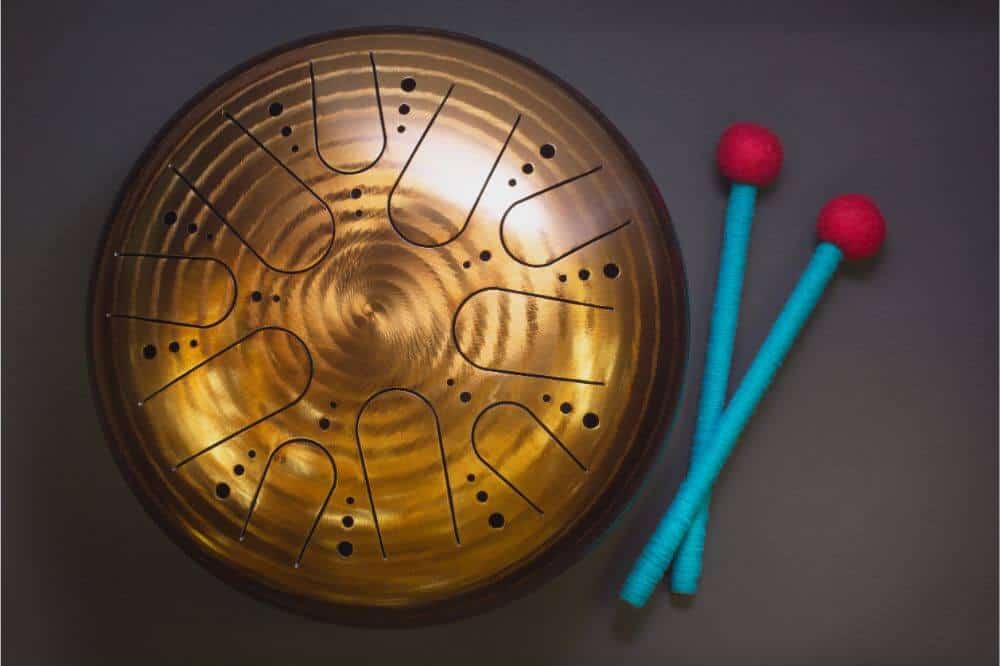The steel tongue drum and the handpan evolved from Trinidad and Tobago’s musical innovators’ designs, where steel drum containers were repurposed into musical instruments.
These instruments are growing in popularity in recent years, with more types, materials, makers, and players worldwide.
If you are trying to choose which pan instrument is right for you, let’s take a closer look at the steel tongue drum vs. handpan.
Differences Between Steel Tongue Drums and Handpans
Both handpans and steel tongue drums look very similar since they are both round metal domes, played by striking with hands or mallets. Both instruments are idiophones, meaning that the sound is created by the instrument’s vibration, without additional resonators.
Because there is no membrane, a steel tongue drum and a handpan are not louder in sound based on how hard they are struck; their loudness is determined by the instrument’s size, shape, and tuning.
And both instruments are inspired by Trinidad and Tobago’s musical and festival traditions, with a special place in Caribbean and Carnival music.
However, they have several significant differences that affect how the instruments are played and sound. Here are the most significant differences.
Tongues vs. Dimples
A handpan has a dimple in the top center, surrounded by at least seven more dimples around it. Each of these dimples is a note field, precisely tuned to the desired pitch and scale.
A steel tongue drum doesn’t have dimples. Instead, slits are cut into the surface of the metal to create tongues. These tongues are of different sizes and shapes, producing different notes when struck.
Sound and Tunability
While handpans and steel drums are both tuned during manufacture, the handpan is precisely tuned to a specific scale. When a handpan becomes out of tune, it needs to be tuned by a professional.
Because the tongues on a steel tongue pan are cut out of the instrument, they are easier to tune and adjust, and the instrument can even have tone and scale customized by the use of strong magnets.
Pros and Cons of Steel Tongue Drum vs. Handpans
Because of these key differences in sound and function, several factors make each instrument a better choice for different players. Here are some of the essential advantages and disadvantages of each instrument.
Sound
The handpan has a unique sound that is often described as ‘magical,’ and handpans are louder and more resonant. Steel tongue drums are a bit more bell-like, with lingering notes.
Ease of Playing
The handpan has larger note fields, so it’s easier to strike and play. A handpan is easier to play quickly. A steel tongue drum is suitable for playing with mallets, if you prefer, but requires more accuracy and precision to get the tongues’ best sound.

Maintenance
Steel is susceptible to heat and cold and can rust when wet or damp. Handpans and steel tongue drums are available in stainless steel, which reduces the chance of rust. Because of the cuts on the surface, steel tongue drums are slightly more susceptible to rust.
Handpans, because they are precisely tuned and difficult to retune, must be protected from both extreme heat and extreme cold. Steel tongue drums are more tolerant of temperature variation.
Options and Varieties
Both instruments are available in a vast range of materials, scales, manufacturers, and so on. Handpans are usually larger in size, at about 20 inches in diameter. Steel tongue drums are smaller and range from 5.5-12 inches in diameter.
Cost
Handpans are much more expensive than steel tongue drums, and low-cost handpans are usually of inferior quality. Handpans also require professional tuning at regular intervals, which adds to the expense over time.
Steel tongue drums are more affordable, and lower-cost steel tongue drums can still have a decent sound. They are easier to maintain and tune yourself with a magnet set and instruction.
Steel Tongue Drum vs. Handpan: Which is Better?
Generally speaking, a good handpan is better than a steel tongue drum. They have a louder resonance, a more unique sound, and more precision tuning. They are easier to play and easier to play fast.
However, a steel tongue drum is still an exceptional instrument, with a long, meditative, bell-like sound, easier maintenance, and much more versatility.
Because they are more affordable, they may be a better choice for a beginner who is learning to play before investing in the expense and maintenance of a handpan.
Both instruments have advantages and disadvantages, and either one can be used to make incredible music. The choice of steel tongue drum vs. handpan all comes down to a matter of preference.

